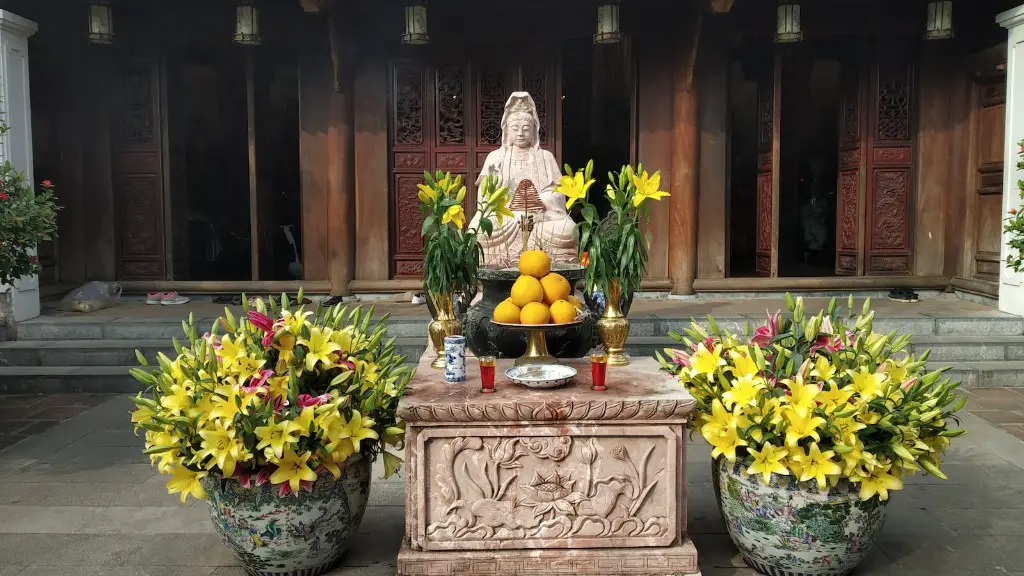Hinduism is one of the oldest religions in the world, having emerged in India perhaps as early as the second millennium BCE. It has also managed to survive in India despite facing many challenges over the centuries. How Hinduism has been able to survive in India is a subject of much debate and scholarship, but there are a few key factors that are often cited for its endurance.
One of the most important factors that have kept Hinduism going in India is its adaptability. Hinduism is an open-ended faith in that, unlike some more conservative religions, it does not have a set of rigid rules and doctrines to adhere to, and its adherents are therefore able to craft their own interpretation from the large and varied texts and stories of Hinduism. This has allowed Hinduism to adapt and evolve as the cultural and religious circumstances of India changed over time, allowing it to seamlessly blend in with prevailing religious and social culture. Furthermore, Hinduism is incorporated with certain traditions that are core part of everyday life in India and thus are not easily supplanted by invasive religious doctrines and practices.
Another key factor for Hinduism’s longevity in India is its inclusiveness. The Hindu faith has traditionally been quite tolerant of other religions, such as Buddhism and Jainism, and has absorbed some of their practices and beliefs into its own fold. This has allowed Hinduism to remain relevant and to remain appealing to a wide range of people who practice a variety of other spiritual traditions.
Hinduism has also been able to draw on the help of powerful patrons, both politically and financially. For instance, powerful Hindu princes and kings, such as the Mughal emperors and Maharajas, have often supported the faith through patronage and grants. This has ensured that Hinduism can continue to enjoy a high profile in Indian society, while also providing funds to help build temples and other religious buildings. That said, however, it should be noted that the patronage of Hinduism has often been selective, with power-hungry leaders sometimes using the religion to control their population, or to acquire a political edge.
The Hindu belief in karma is another factor for Hinduism’s survival in India. According to Hindu philosophy, good actions lead to positive results and bad actions lead to negative results. This has allowed Hinduism to enact a sort of self-regulating mechanism within Indian society, as people have internalised this belief and have generally shy away from behaviours and practices that go against Hindu philosophy. This has ensured that Hinduism can remain a respected and relevant faith in India, with people naturally avoiding any practices that may be seen as an affront to their faith.
Finally, there has been a large amount of support and commitment from the Hindu population in India that has helped to secure the faith’s continued success in the country. Hinduism has its share of devout followers who are passionate and dedicated to their religion, and they have been instrumental in keeping the faith alive by engaging in rituals and festivals, by upholding its values, and by providing pious donations and contributions to the temples and other religious sites.
Caste System
Another key factor for Hinduism’s survival in India is the deeply entrenched caste system which forms a central part of Indian society. According to Hindu scripture, those born into a particular caste are obliged to follow the customs and codes of their caste and are unable to change without causing disharmony in society. This has created a sense of belonging within Indian society, and a hierarchy which has been largely resistant to external pressure. While the caste system has often been viewed as a negative influence in India, it can also be seen as providing a level of stability to Hinduism, giving it a hard and fast sense of identity which has allowed it to survive in times of great change and upheaval.
Furthermore, the caste system has also provided a somewhat unified religious identity and has drawn Hindus together, often galvanising them in times of strife and cruelty. By creating a hierarchical structure within which members of each caste feel a kinship and loyalty to their fellow co-religionists, Hinduism is afforded a certain level of unity and steadfastness which is crucial for its survival.
Secularism
The advent of Indian independence in 1947, and the adoption of secularism as the country’s official policy, has also provided the religion with a certain level of protection. Secularism has meant that Hinduism is not treated any differently from other religions and that it is largely allowed to exist unmolested. This has provided the faith with a buffer from persecution and has given Hindus the freedom to practice their religion without having to worry about discrimination or repression.
This being said, however, it should be noted that secularism also brings its own set of challenges for Hinduism. For instance, as religious beliefs are not imposed upon people and are instead seen as a matter of personal choice, this can lead to a certain complacency amongst those born into the faith and a lack of commitment to its values and customs. This, in turn, can lead to Hinduism becoming less relevant in the day-to-day lives of many Hindus, leading to a gradual weakening of its cultural imprint in India.
Preservation Of Hindu Scriptures
Furthermore, the preservation and proliferation of Hindu scriptures, such as the Vedas and the Upanishads, as well as the Sanskrit language, also play an important role in Hinduism’s survival in India. These sources of religio-cultural knowledge provide the basis for understanding Hinduism and allow people to connect with its teachings and traditions. For example, by reading the Vedas and other scriptures, Hindus can gain a deeper understanding of the faith and learn more about its values and customs. This knowledge then gives Hindus a greater appreciation of the faith and motivates them to keep its traditions alive.
Moreover, the maintenance of Deities and temples has also been instrumental in Hinduism’s conservation in India. These sacred sites provide a safe and secure environment in which Hindus can commune with the Divine, and they offer a sense of comfort and solace for those going through life’s struggles. Furthermore, by creating spaces for Hindu religious rituals, such as puja ceremonies, Hindus can come together and strengthen their faith as well as providing a much-needed sense of community and connection.
Resistance To Western Ideas
Finally, the resistance to western ideas and theories has also been crucial for Hinduism’s survival in India. Although many western concepts, such as science and technology, have been embraced by Indian Hindus, there has also been a notable reluctance to supplant Hindu beliefs and customs with western ones. This staunch adherence to Hinduism has allowed it to remain intact and to resist the spread of western “cultural imperialism”. By maintaining its core values and customs, Hinduism has been able to stay relevant in India and has helped it to survive in the face of many challenges.
Societal Support
Finally, Hinduism has also been able to draw on the support of larger Indian society, which has been quick to rally behind the faith in times of need. For example, in recent years, there have been numerous campaigns and protests launched by Hindus to defend their faith from aggressive missionary activities and other threats. This has been instrumental in helping Hinduism to establish a foothold in India and to remain relevant in society.
Moreover, in recent years, there have also been various attempts by Hindu organisations, such as the Vishwa Hindu Parishad and the Arya Samaj, to promote Hinduism and to provide education about the faith, its values and its customs. This has meant that, even in an increasingly modern India, there is still a strong Hindu presence. Furthermore, Hindus have also been quick to embrace technology, which has allowed them to establish a greater global presence and to use the internet to share their faith and cultivate a greater understanding of Hinduism.
Preservation Of Culture
Finally, it should also be noted that Hinduism’s success in India has been due, in no small part, to its willingness to embrace the many cultures and languages of India. For example, Hinduism has adopted local languages and scripts such as Tamil and Gujarati, which has made the faith more accessible to different communities in India. This has allowed Hinduism to remain relevant to Indians of all languages, while also providing it with a gateway to spread to other cultures and nations.
Furthermore, Hinduism has also been able to make use of the ancient Indian tradition of aagama, which involves inculcating traditions and customs into the fold of Hinduism. This has allowed various regional cultures, such as those found in Karnataka, Rajasthan and Maharashtra, to be embraced and, in the process, has helped to ensure the survival of Hinduism in India.
Adaptation
Finally, Hinduism’s success in India can also be attributed to its willingness to adapt to changing circumstances. Hinduism has, over the years, absorbed many different customs and beliefs while also preserving its core principles. This has ensured that Hinduism remains appealing to different communities and allows it to interact with new and emerging culture and trends. This adaptability has allowed Hinduism to remain relevant and to survive in India.

